Subscribe and you will promptly receive new published articles from the blog by mail
Do you know how much more profitable it is to use a remote development team instead of a full-time staff? Purchase of expensive equipment, staff training, and stable expenses on salaries can be evened out by delegating the task to third-party IT teams. In 2024, you will find enough technical solutions to control the team remotely and protect confidential information from leaks.
Technological progress, like evolution, is a logical and irreversible process affecting all business areas. Recent data from 2024 workplace studies demonstrates this transformation:
– 14% of full-time employees are now fully remote, with an additional 29% working in hybrid arrangements
– 98% of workers express a desire for at least partial remote work options
– By 2025, an estimated 32.6 million Americans (22% of the workforce) will be working remotely
– 83% of U.S. employers report remote work arrangements as successful
A striking example of this is a study by Fortune Business Insights, stating that the digital transformation market is expanding. According to analysts, its value will grow to $6.78 trillion by 2029, which is more than the annual budget of most countries.
When we talk about digital transformation, we mean not only technologies and programs but also migration to modern work models. Namely, Outsourcing and Outstaffing.
According to Research And Markets experts, the IT outsourcing market is forecasted to reach a value of $632 billion by 2027, with a CAGR of 4.13% from 2022 to 2027. This is because many global companies have already appreciated the benefits of outsourcing and have hired experts for development instead of maintaining their own staff.
One can argue as much as one wants about which development model is better and more reliable. Or you can study the material collected by Roobykon Software experts on “How to effectively manage remote employees” and make conclusions about the benefits and problems of outsourcing.

Challenges in managing remote teams
Since the virtual team works remotely, the opportunity to monitor progress is reduced. Other challenges also arise, which can negatively affect both productivity and quality. But only when employers make mistakes in remote team management. Which ones, and how to avoid them? Let’s find out.
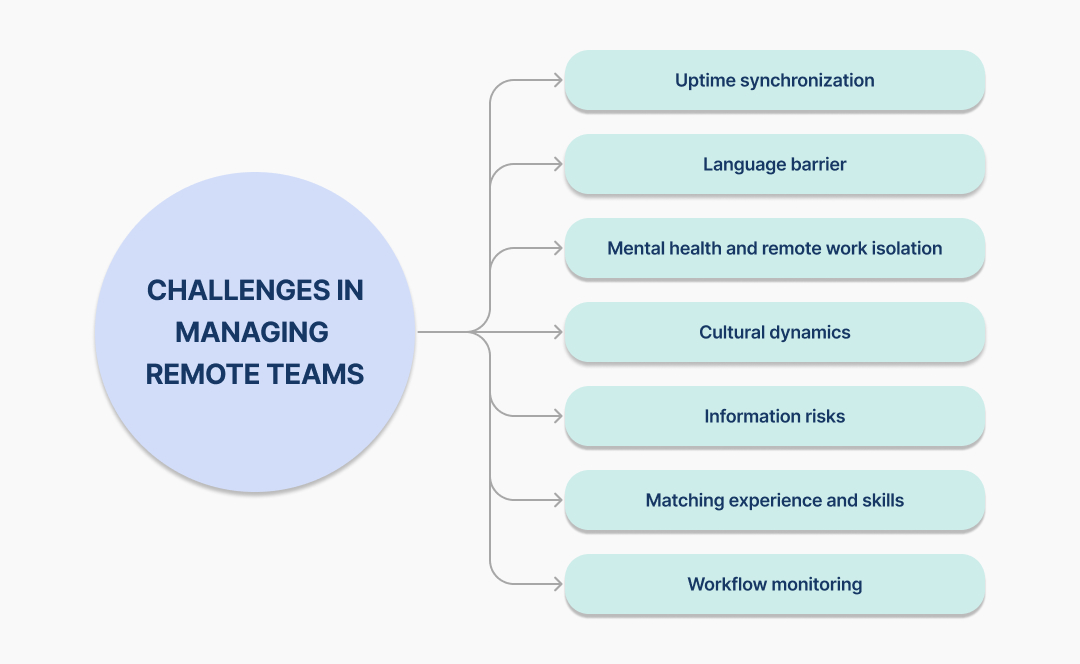
Uptime synchronization
You will encounter a time difference if you hire developers from another country, especially a remote one. Sometimes the gap between regions can be more than 12 hours, thus negatively affecting the interaction with the contractor. Accordingly, this will cause a series of discussions about working hours, organizing meetings, communication in general, and controlling the progress.
Use one of three options to resolve the dilemma:
- Set convenient meeting hours for both parties at once, agreeing on the scope of the edits and the timing of the work.
- Synchronize your working hours with the time zone difference, which will cause discomfort for both parties.
- Use CI/CD tools to monitor work and hold periodic meetings with progress demonstrations.
An alternative is to hire remote employees from your own country or one of the neighboring countries. But there is also a problem; in some regions, for example, the United States, the rates are much higher than in Eastern Europe or India.
Language barrier
Similar to the previous problem of managing employees working remotely, hiring workers from remote regions can have unpleasant consequences. For example, employees from Asian or Indian regions or African countries, although they know English, have a pronounced dialect. This, in turn, makes communication difficult and can lead to misunderstanding of the TOR by the contractor.
As a result of cooperation, you can get a finished project with completely different specifications than expected.
This is the most unfortunate example. The reality is much better. The IT industry is completely internationally oriented; the pay is in dollars, and the language is English. You don’t have to worry about hiring remote developers, especially from the members of the Roobykon Software team.
Mental health and remote work isolation
The invisible cost of remote work often manifests in team members’ mental well-being. The home office, while comfortable, can become an isolation chamber where the lines between professional and personal life blur dangerously.
Remote workers frequently report experiencing prolonged periods of solitude, leading to decreased motivation and emotional disconnection from their teams. The absence of casual office interactions – those spontaneous coffee breaks or corridor conversations – creates a psychological vacuum that can significantly impact team morale.
Cultural dynamics
When managing remote teams across continents, cultural differences transform from an abstract concept into a daily operational reality. Beyond the obvious language nuances, deep-rooted cultural approaches to work, communication, and hierarchy can create invisible barriers to project success.
For instance, team members from high-context cultures might find direct feedback from Western managers uncomfortably blunt, while those from low-context cultures might perceive indirect communication as confusing or inefficient. Decision-making processes vary dramatically – what one culture considers collaborative consensus-building, another might view as unnecessary delays. Even simple acts like scheduling meetings require cultural awareness; while some team members might readily extend their workday into personal time, others maintain strict work-life boundaries based on cultural norms.
Information risks
If you are going to manage a team online for the first time, you should understand that the confidentiality of your project plays a key role. Ideas, tech stack, concept, design – any data leakage plays into the hands of competitors. No matter your business, you obviously don’t need such a turn of events.
To protect yourself from unpleasant situations, information leaks, and other risks, you must sign an NDA with a potential contractor before negotiating a project. Complying with this rule will protect your company from reputational and financial losses. Also, in case of precedents, you will be able to claim compensation from the culprit commensurate with the damage caused.
Matching experience and skills
When choosing contractors to implement a project, don’t forget to ask them about their skill levels in a particular tech stack. Often companies overstate the experience, hoping to attract customers. During development, the difference between the specified expertise and the real one becomes apparent, affecting the timing and quality of work.
To avoid such situations in remote team project management, follow three steps:
- Find out about the team’s real skills through feedback and portfolio cases.
- Hold a meeting with the company’s representatives and give them a test assignment to confirm the experience.
- Choose a team from a well-known company that has completed hundreds of projects.
Contrary to the widespread opinion about the overpriced rates of big-name developers, the situation is much better in practice.
For example, the hourly rate in Roobykon Software does not exceed the average for the West-European region, and the quality of work is competitive with the native teams in the USA. This is especially visible in projects based on Sharetribe, which the company’s experts have released more than 60 for customers worldwide.
Workflow monitoring
Many startup and company owners do not understand how to work with remote teams. They imagine many potential problems and disadvantages, 99% of which either do not arise or are leveled out by remote team management tools.
Plenty of working tools help managers efficiently distribute the work of remote teams on different schedules. The same goes for the progress trackers. Not only can you and should enter tasks into them, but you also track the completed work with a progress chart or demonstrations.
Here are some well-known tools for remote management of development teams:
- Slack
- YouTrack
- Pivotal Tracker
- Asana
- Microsoft Teams
- Trello
- Kazoo
- Jira
- Basecamp
The contracting company may offer you their preferred tools to manage remote teams. Either way, these digital solutions will help you better control your company’s work and make timely adjustments to improve development efficiency.
Strategies for building a remote work team
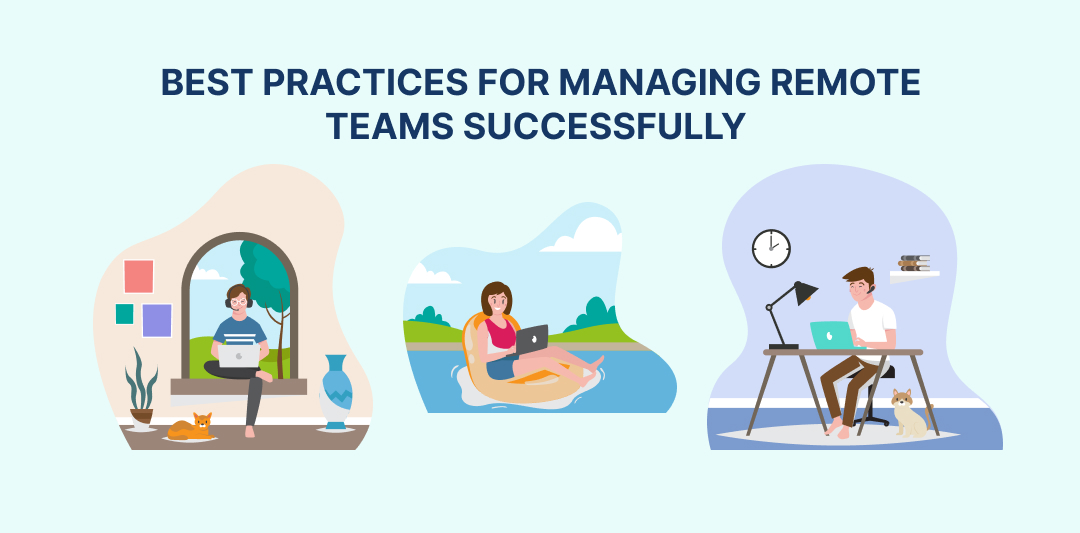
Depending on the project scale and its peculiarities, you can choose among several team-building strategies. There are two common options:
- Gather diverse specialists on freelance and build a team from them.
- Hire a dedicated team from the developer company.
Both options have advantages and disadvantages, affecting different aspects of your project’s development. Let’s walk through each in detail and determine which is better to choose, depending on the goals and complexity of the tasks.
Typically, an IT project consists of:
- Back-End
- Front-End
- Design
- DB
- Quality Assurance (QA)
A total of four components can have subsets of frameworks, technologies, and methodologies. To manage remote teams successfully, you also need a project manager. Here comes the key challenge: team coordination and coherence, which can only be solved by years of experience in the industry.
Gather different freelance specialists
If you decide to hire performers on freelance platforms, then prepare for the following nuances:
- freelancers are loners who are not used to working in teams;
- freelancers have a wide range of skills, but mediocre levels in each;
- although the selection of talent is vast, experts among them are usually rare;
- team building will require hiring a diverse set of specialists;
- an experienced in-house or freelance project manager is needed to manage the team;
- impressive expenditure of time and resources on team building.
Of course, you can find a full-stack developer who wants to be a part of an IT team and entrust them with engineering the whole project, but only if you are willing to wait. Therefore, freelancing is suitable for large-scale projects but only as an extension of existing teams or delegating third-party tasks.
Hire a dedicated team from a company
Experience and teamwork are the keys to successful and timely development. If you want to effectively manage a remote team, hire a formed group of developers from an IT company working on the Outsource model, for example, Roobykon Software. The advantages of working with established teams:
- the contractor provides all the skills needed for the project;
- companies have extensive development experience;
- communication and distribution of tasks is well established;
- each team of experts is assigned a team lead;
- contractors provide their project managers, who have worked with dedicated developers before;
- well-coordinated teams are experienced in using management software;
- company representatives do not require additional briefings and elaboration of interaction mechanics.
Altogether, dedicated remote teams handle complex projects better than freelancers. This is due to the experience and coherence of the developers, who are used to interacting with each other regularly.
What is better?
Hire freelancers if you want to save money or have a small amount of work with low-quality requirements. They have more loyal rates, flexible schedules, and comprehensiveness of skills. However, at the same time, they may be inferior in experience to teams and difficult to integrate into an established work environment.
The situation with dedicated companies is more interesting. They will offer your project comprehensiveness and expertise, demanding a higher remuneration in return. Working with successful remote work teams, you get:
- high speed of development;
- complexity of services:
- development
- design
- testing
- project management
- work flexibility;
- team self-sufficiency;
- adherence to the TOR, specifications, and deadlines.
In summary, hiring remote developers from companies or even dedicated teams is an optimal investment in the future of your digital product and brand reputation.
Ways to boost employee performance
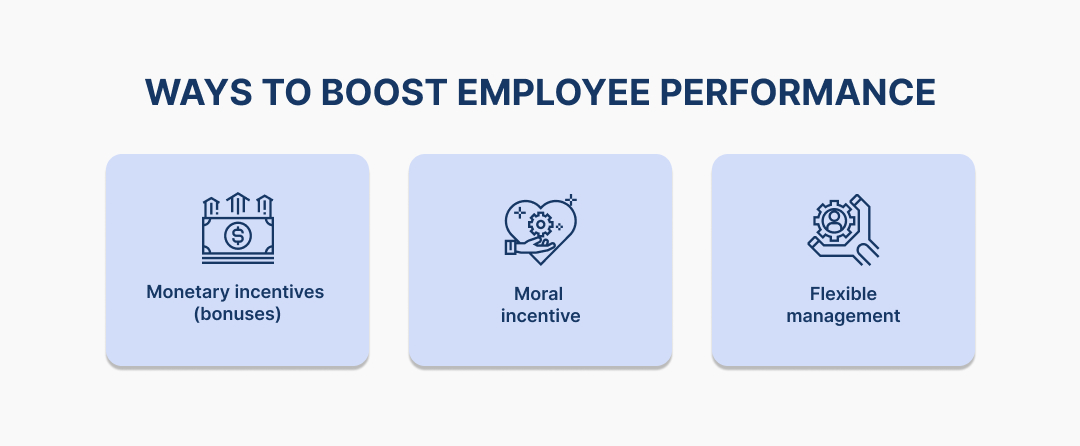
When working with outside contractors, the problem of decreased productivity can arise. It turns into unpleasant outcomes, namely:
- deviations from project schedules;
- delays in demonstrating product readiness;
- slowdown in the speed of work;
- indifference of the team members to the quality of the product;
- postponement of the release date.
These are all consequences of improper remote work performance management strategies. To avoid them, you should know how to properly motivate your contractors for development productivity. There are at least three techniques for this.
Monetary incentives (bonuses)
It is no secret that salaries in the IT industry are high. Consequently, cooperation in developing digital solutions is relatively expensive for the employer. The project’s cost includes the hourly rates of experts and the time spent on it, the complexity of the task, and some other nuances.
Some performers may feel their efforts are underpaid, especially if the contract is negotiated on compromise terms. Accordingly, their productivity may decrease.
To avoid such situations, you can reward contractors with bonuses for urgency, being ahead of schedule, and other achievements. But only if your budget is not severely limited.
Moral incentive
Everyone seeks recognition for their skills, talents, or hard work, regardless of their profession. That’s why it’s essential to recognize developers when communicating with remote teams. Simple praise (not to mention monetary praise) can motivate any contractor to be more productive.
As a rule, the Team Lead’s role is to support the working spirit and high productivity. But the Product Owner can act as a catalyst for inspiration. By showing interest in the state of the project and its technical aspects, you demonstrate the importance of what the experts do for you. This is as motivating as a ringing coin.
Flexible management
To keep remote workers productive when bringing your idea to digital life, you need to be flexible. This applies to schedule management and aspects of your work. For example, it is worth making concessions to developers if it benefits the project. Management flexibility includes:
- responding to development challenges;
- compromising on schedules and deadlines;
- quality control and adjustment of tasks;
- considering the opinions of the contractors;
- partial freedom of action for a performer.
Allow the professionals to remain so, even when in direct command. Consider the team’s opinion, respond to challenges promptly, and be more loyal.
Project management methodologies: an excursion into types of management
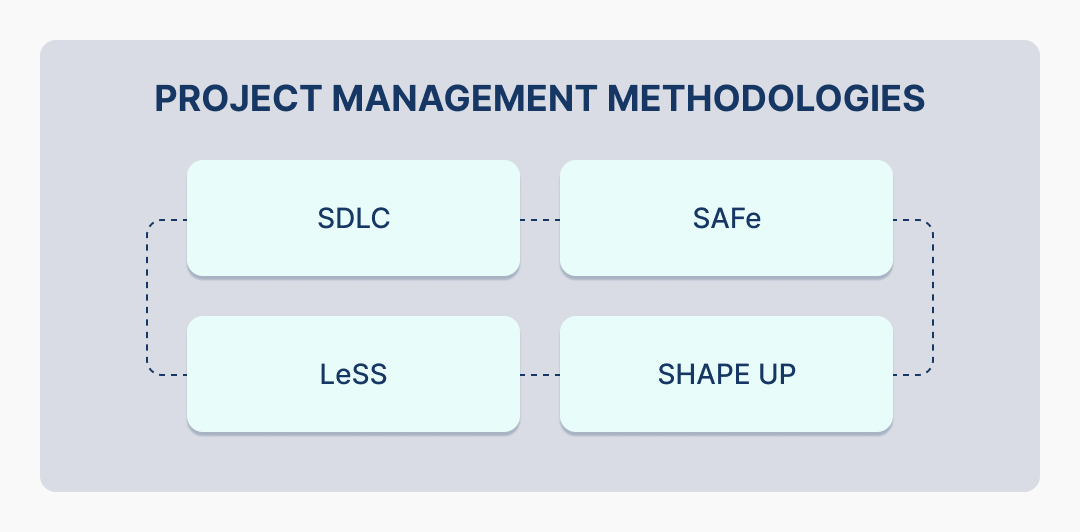
Since the first development methodologies, namely Waterfall, Lean, Radiant, and others, project management techniques have undergone significant transformations. In 2024, more than 90% of developers and their clients use Agile and its derivatives. Since most processes are implemented flexibly, the approach to control them must be appropriate.
Project managers and team leaders now rely on defining key tasks and adapting them to the team’s capabilities. This is why a project can be transformed at almost any moment. What does this mean?
For instance, there is a task to implement several functions within the N-spring. During the work, problems emerge that are better to fix in the next stage. The team focuses on other functionality and postpones the problematic functionality for later. This allows you to maintain high productivity throughout the project without sacrificing its final quality.
Want to know how to manage remote teams correctly and efficiently? Check out four key methodologies for organizing your work. By choosing one of them (tailored to your project), you will ensure maximum productivity and timely digital product release.
SDLC
The software development lifecycle is a comprehensive process of working on digital products, which defines the scope of the project, its goals, and key tasks. The SDLC aims to ensure the final quality of an IT solution. The methodology consists of six key phases:
- Planning. The stage defines the audience, user needs, risks, alternatives, and market offer.
- Analytics. Create technical documentation, determine how the software works, and research the potential technical base.
- Design. Graphic and architectural models to compare and choose the best option for the IT product.
- Development, testing, deployment. Write code, implement integrations, and test the system.
- Due diligence, bug fixing. Test UX, collect feedback, take opinions, and upgrade the system.
- Support. Collect analytics and metrics on software usage and technical or operational bugs. Fix bugs.
The cycle itself has a limited period of existence. It starts at the stage of discussing the idea and ends with the withdrawal of the digital product from the market. This is one of the best practices for managing remote teams, a comprehensive approach to solving problems.
SAFe
Scaled Agile Framework is an optimized set of templates for working on IT projects. It defines roles and prioritizes tasks and interaction structure during solution design, development, testing, and support.
SAFe focuses on supporting the culture of interaction between the company and the contractors. The methodology is built on nine basic principles:
- An economic view of the product. Minimizing budget spending by optimizing the achievement of goals in a specific time frame.
- Systematic thinking. A comprehensive view of the product will identify basic priorities and focus efforts on achieving them.
- Process flexibility without sacrificing parameters. Focusing the team’s efforts on achieving the goal, considering compromises in the processes without changing the original goals.
- Short cycles focused on short-term results. Fast integrations allow you to upgrade the product in stages, making minimal changes and achieving high productivity.
- Objective evaluation of the system. Documentation describes how the system should work, but the demonstration shows its actual state.
- Limiting WIP states. While working on the software, it is essential not to leave “tails,” which are considered unfinished components. Therefore, you must close tasks step by step.
- Space for maneuvering. The principle of agile development itself implies freedom, but the synchronization of tasks opens the possibility to make changes in a project.
- Consideration of employee motivation. The team is a single mechanism, where each developer acts as a cog. If it fails, the whole algorithm is disrupted and fraught with problems.
- Decentralization of management. If strategic decisions are made at the top, then the immediate executives should resolve the actual tasks autonomously.
The SAFe method, like the SDLC, is considered one of the best ways to manage a remote team. It gives the executives some freedom to choose their priorities and technological aspects. This, in turn, has a positive effect on the teams’ productivity.
LeSS
Large-Scale Scrum is a methodology for effective collaboration between multiple teams on a single project. It is easy to use and has instructions on how to organize work. Nevertheless, the methodology is widely used in practice, and there is a clear profit in it.
LeSS is based on 10 principles:
- Scale. Projection of ideas and values of Scrum to many teams simultaneously.
- Control. Detail tasks and follow instructions to solve them.
- Transparency. Measurable results demonstrate a progression of goals for each team, individually and collectively.
- Comparison. Projecting performance against goals, comparing actual progress against plans.
- Integrity. Focusing on strategic objectives instead of parts.
- Customer centricity. Considering the requirements of your target audience and designing your work to achieve them.
- Idealization. Minimizing iterations, focusing on the maximum value of each version.
- Generalization. Looking at the system as a whole instead of parsing its components.
- Resource reduction. Minimal effort to achieve maximum goals: one developer per task instead of a team.
- Massiveness. Dozens of teams in management should show maximum productivity
What is good about the LeSS methodology is that tasks are assigned to teams at the beginning of a sprint and adjusted at scale. Instead of prioritizing small checkpoints, the focus is on the overall quality of the potential system. This promotes a cohesive digital product with all components well synchronized.
Shape Up
The Shape Up methodology is the specification of processes and project goals, as well as the definition of ways and frequency of communication to adjust current tasks. It focuses on an early assessment of the critical priorities of the future product and the formation of a unified strategy for its development.
Shape Up is based on five principles:
- The sprint is 1.5 months long. This is enough to implement several components of the future system.
- Task structuring. Senior experts of the team study the project and competently distribute tasks.
- Shared responsibility. Teams focus on achieving goals, leveling out the weaknesses of individual participants.
- Risk minimization. Due to competent management and task distribution, the timeliness of iteration release is achieved.
- Productivity assessment. Relevant tasks are selected for each sprint, and results are measured by the number of goals achieved.
Shape Up may be inferior to other techniques, but it is still considered one of the best practices for leading remote teams.
Top 10 tips to effectively manage remote employees

Do you know how to eliminate up to 99% of problems with external performers? Roobykon Software experts have prepared a brief guide on working with remote teams to help you cope with complex situations. Follow the advice and efficiently manage your contracted developers.
- Integrate remote employees
Ignoring the team members is bad, even if you’ve already explained all the nuances to the team manager. Hold a comprehensive meeting with developers using Zoom, Meets, or other tools, where you can get to know your contractors. Talk about your goals and ideas; ask for opinions. This will help better engage your contractors in the project and make them more productive.
- Even out the time difference
If you and your development team have a significant time zone gap, you don’t have to adjust, causing discomfort. It is easier and more efficient to use the best project management software for remote teams. The fact that you cannot track your progress in real time is frustrating, but it can be leveled out in other ways. For example, agree on the frequency and hour range to demonstrate the product’s readiness.
- Remove the language barrier
You probably won’t have a problem with this since English is the main language in IT. But if you encounter an issue with mutual understanding, you can hire or appoint a communications officer and a translator. However, this is justified only when the cost of hiring and the overall benefits exceed the cost of employing additional staff.
- Agree on deadlines
Outlining a timeline for the project is extremely important. You may want to change or redo something. Therefore, you should set a deadline one month before the planned release to the market. This approach will leave room for maneuvering, such as additional testing or collecting feedback from a limited number of users, working on bugs, etc.
- Sign NDA
No details before signing an NDA. If you do not want to encounter theft of ideas by competitors – always sign a non-disclosure agreement. This will save you time, nerve cells, financial and reputational risks.
- Choose tools for managing remote teams
Teams usually offer their own toolset. If not, ask contractors to find convenient apps or systems to monitor progress and adjust tasks. It’s better to spend time deploying and configuring such solutions than face communication problems.
- Organize meetings
Set reporting timelines, tying them to online meetings. Organize demonstrations of completed work, and communicate with development participants at least once a month.
- Appoint communication managers
The development team has team leads and project managers. You should also have one person in charge of communicating with contractors and supervising the work. They are the ones to make edits and check iterations; you need to appoint an expert with technical skills and knowledge of the project’s specifics.
- Don’t keep silent about problems
We’re all human, and we all make mistakes. Therefore, take an interest in your contractors’ difficulties and participate in solving them; discuss the differences between the actual progress and the planned one. Thus, you can identify development problems in advance.
- Adhere to communication norms
Remember: you don’t owe anyone anything, nor does anyone else. You have a commercial relationship with contractors; you pay for the project, and they implement it. There is no place for personal emotions or projecting problems. Communicate with your partners respectfully, take an interest in their progress, praise them, or work on their mistakes. This approach will likely motivate remote developers regardless of project complexity or team fatigue.
Conclusion
The quality of your IT product, as well as the timing of its implementation, depends entirely on the productivity of the development team. But productivity is the result of effective contractor management. Therefore, if you want to reach a consensus in matters of management – hire experienced teams who will take some of the tasks of organizing the work themselves.
Realize your ambitious plans correctly and quickly with the help of dedicated teams from the Roobykon Software staff. Get access to years of experience and a wide range of skills with fair pricing. Delegate your project to industry experts and forget about the challenges of development management.
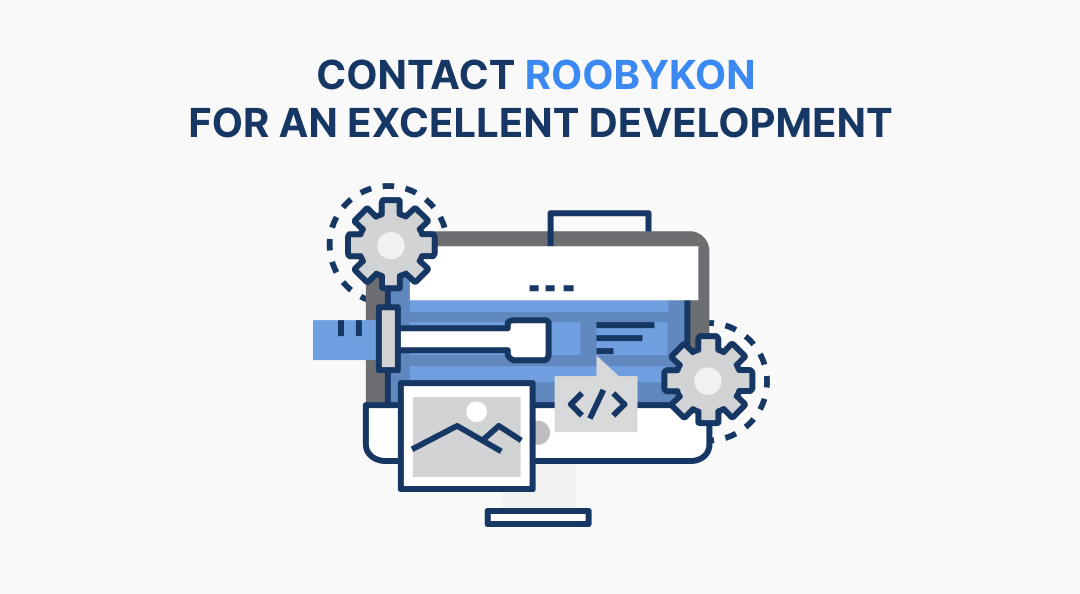
Recommended articles
 Top Reasons to Opt for Software Project Development Outsourcing
Top Reasons to Opt for Software Project Development OutsourcingStruggling to meet development deadlines or facing a shortage of skilled talent? Explore the compelling reasons why outsourcing your software projects can be the solution you've been seeking.
 Measures of Success: Identifying Key Performance Indicators for Your Marketplace
Measures of Success: Identifying Key Performance Indicators for Your MarketplaceSo your marketplace seems to be growing steadily - but how can you be sure this growth is sustainable? There are a few important indicators that you need to keep track of to be confident you’re headed in the right direction.
 7 Reasons People Are Afraid of eCommerce and How to Deal with Them
7 Reasons People Are Afraid of eCommerce and How to Deal with ThemWhile eCommerce has revolutionized the retail industry, it has also given rise to various fears among potential shoppers. This article explores seven major reasons why consumers are wary of eCommerce.






